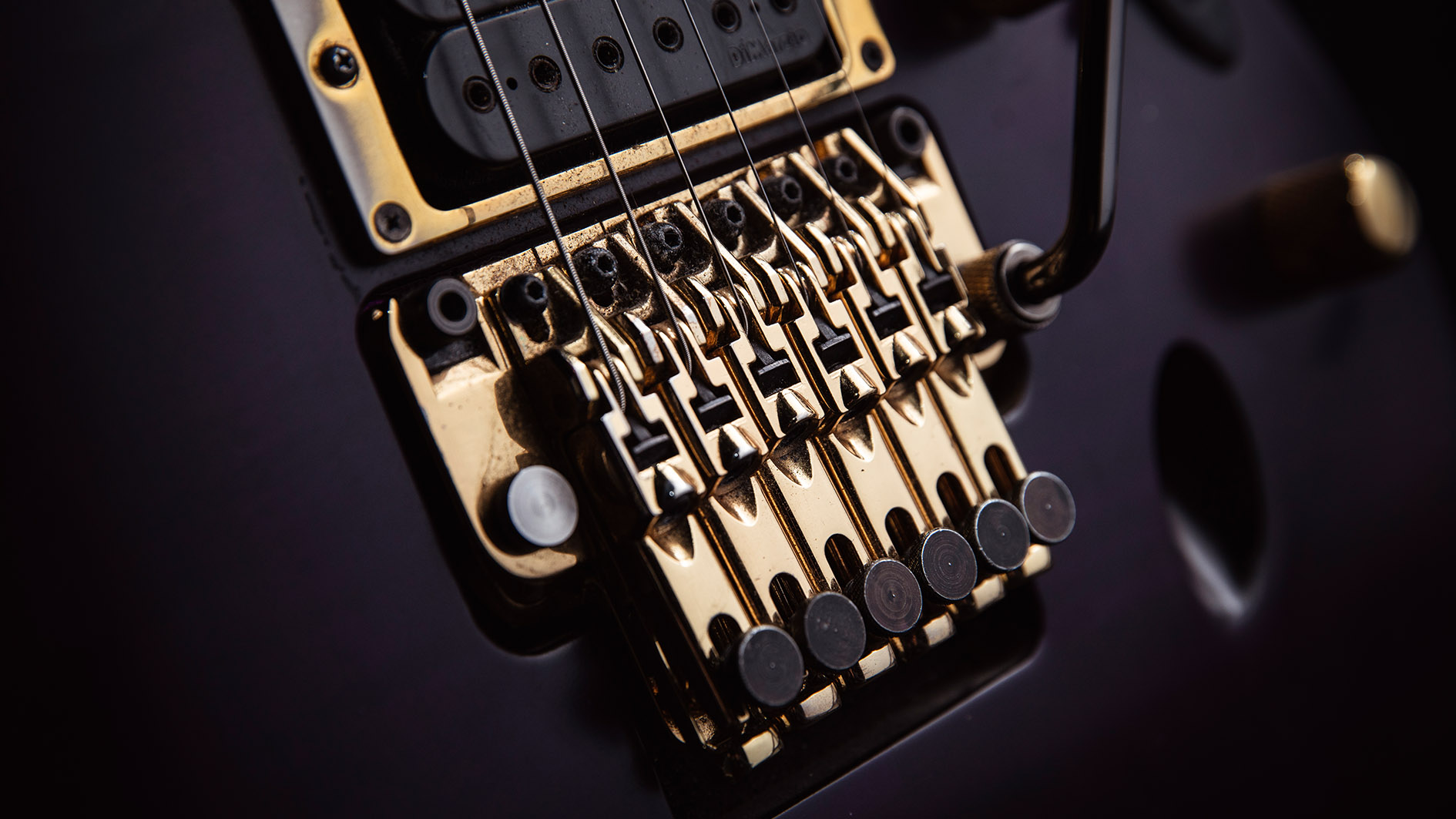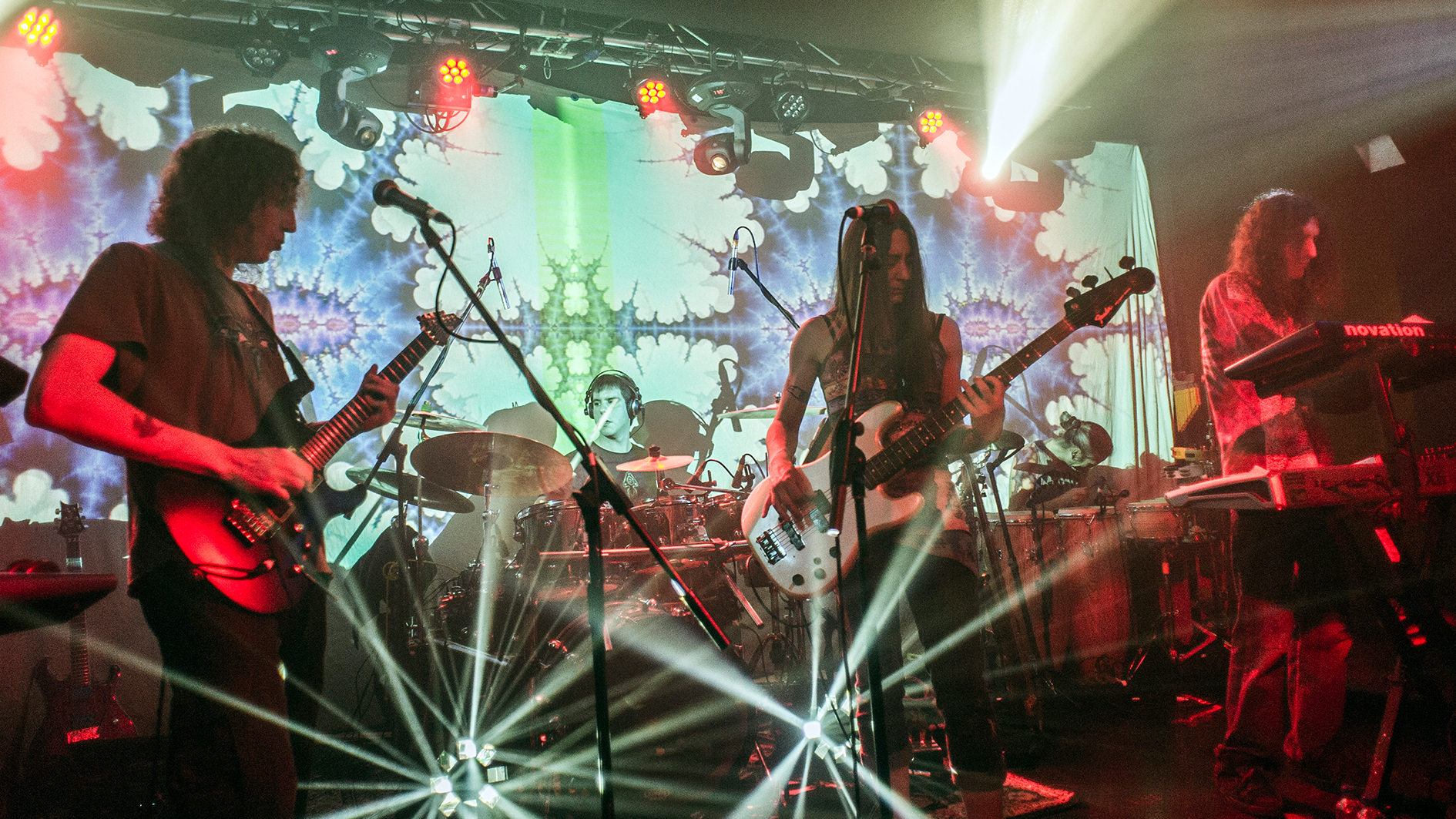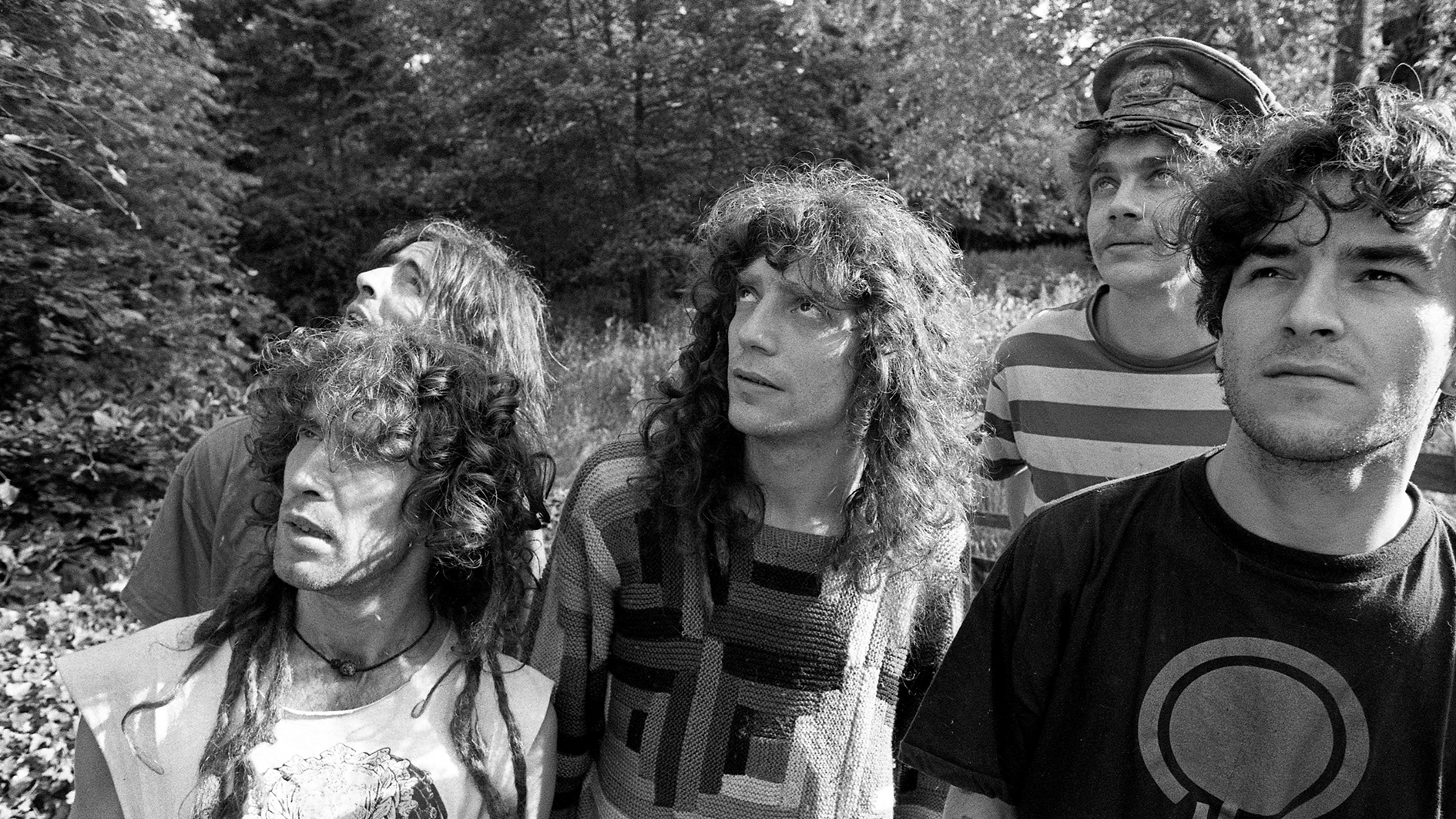Ozric Tentacles’ Ed Wynne: "George Harrison used to come to our house for dinner and sit there playing guitar!"
We touch down on planet Earth with the captain of the Tentacles’ space-rock craft following the release of his debut solo album, Shimmer Into Nature

Some 36 years after inadvertently forming Ozric Tentacles in a field in Wiltshire (and as many albums later) Ed Wynne released his debut solo LP, Shimmer Into Nature. Produced and mixed by Ed at his home studio in rural Scotland, it’s a genre- bending trip of an album that instinctively leans on the guitarist’s most essential influences of psychedelia, prog rock, world music and electronica.
During last year’s tour with the legendary Gong, we asked Ed what his plans are for Ozric Tentacles now that his solo career appears to be officially underway. “It’s on hiatus, and I’ll get back to it,” he told us. “But for now, I’m loving this incarnation.”
In what ways does Shimmer Into Nature contrast with Ozric Tentacles, and what made you decide to go about it separately?
“It used to be that Ozric was the freest band and would do any style or any genre and anything goes, but it’s become a bit of a sound now. I thought, ‘I’m going to stretch out, make some clean sounds and enjoy my own company in the studio for a bit.’ It’s quite weird seeing my name on the [album] title, but it’s been my ambition to do it - and I’ve been doing it and now I’ve done it and I’m happy with having done it.
My father [sculptor David Wynne] was very solo and independent. He always said, ‘Try doing it on your own and see how it feels.’ To be honest, it does feel quite nice and interesting. I’ve done my rock band thing... Even if it did sound a bit rocky last night when I switched the wah pedal on. I was like, ‘Sorry guys, we’re back here again!’”
Were you encouraged musically from an early age?
“I grew up thinking that being a musician was a completely okay thing to do. My dad was commissioned to [bronze cast] the heads of The Beatles at the height of Beatlemania and, consequently, he became very good friends with them, especially George Harrison and Ringo.
Get The Pick Newsletter
All the latest guitar news, interviews, lessons, reviews, deals and more, direct to your inbox!
When I grew up, I thought, ‘I want to be one of those people. They’re having fun. I’m going to do that'
"George used to come around to our house for dinner and sit there playing guitar. And the house next door was rented by Donovan. That’s where I used to go after school, because it was more fun than what was happening in my house, generally. I mean that was fun, too, but Donovan had guitars and strange flavors of smoke in the room. It was all fascinating.
“When I grew up, I thought, ‘I want to be one of those people. They’re having fun. I’m going to do that.’ And I was thankfully very much encouraged to do that. I was very, very fortunate. My dad said, ‘Okay, that’s cool if you’re leaving school at 16 to do music, but you’ve really got to do it, because you can’t be supported forever like this. Give it two years and see how you’re doing.’
"10 years later, I was still skint! But I was starting to interest people with what I was doing.”
How did your sound come together in terms of the equipment you were using?
“Donovan lent me his ‘Silverface’ Fender Twin Reverb amp. It was really nice, but it was a bit clean for me. Eventually, I got a Strat, which went with the Twin quite well, but it just wouldn’t stay in tune. You’d only need look at the tremolo and it would go out of tune, so I got rid of it.
"Then Donovan invited me out to Palm Springs in California for two weeks to work on some of his tunes with him. This was around 1978 or ’79. He had all these guitars and he gave me this old Gibson Super 400[CES] with humbuckers. I said, ‘Are you sure?!’ and he said, ‘Yes, yes. I’ve got loads of guitars, and I’d like to thank you for coming over here and helping me.’

“When I got home, I thought, ‘It’s lovely, but it’s not me,’ so I phoned up Donovan and asked him, ‘Would it upset you if I sold [the Super 400CES] and got something a little bit more like what I want?’ and he said, ‘That’s cool. That’s fine.’ I got about £750 for it, which isn’t much, but it was enough to buy my Ibanez Artist with its super powerful pickups and everything.
"When I got that, my sound was suddenly correct. I got my Marshall, I got my echo pedal, and I got my wah-wah... Now I’m away with the fairies!”
How important were bands like Hawkwind to you at that stage?
“Hawkwind was an amazing thing for me. After I left school, I got right into them. I still think Levitation is their best album. It has Tim Blake on synths and Ginger Baker on drums. It’s a weird combination, but I love it. I was obsessed with them for a bit and then I became less obsessed with them. But I still love Hawkwind, I always will.
I had this burning passionate feeling in my solar plexus that I needed to do something
"Gong were much more of an influence, particularly when Steve Hillage and Tim Blake were in Gong for those three albums. [Flying Teapot, Angel’s Egg and You] are three of the most amazing albums in my world. I learned a lot from those, mainly from Angel’s Egg and You. They’re always with me in my head. I can always hear them in my mind.”
Did you have a musical vision when you formed Ozric Tentacles in 1983?
“Not really, other than the fact I had this burning passionate feeling in my solar plexus that I needed to do something. I remember phoning up some people who I knew were musicians and saying, ‘I need you to come over now, please. There’s this festival at Stonehenge. Let’s just get a generator and plug in and do this thing.’
"So we went down to the Stonehenge festival. We’d hired a generator, parked our van, made a fireplace and plugged in a couple of amps. I was playing away and having a laugh when I looked up and saw 40 people sitting around us. When I looked up again there were 300 people there! I was in the middle of a gig all of a sudden. I hadn’t intended that to happen.

"I was going to just sit there and jam quietly with friends, get spaced out and watch the stars, but it turned into a bit of a thing. “Someone came up to me afterwards and said, ‘What’s going on here? What are you called?’ and I said, ‘We’re called Ozric Tentacles, mate. I don’t know what the hell’s going on here, but I’m enjoying myself!’
"It just expanded slowly from there. We got bigger and bigger until eventually it ended up that there was always a gig on Friday. It was complete improvisation: we had no tracks at all. These gigs were often about six hours long.
"Someone would pick a key and we’d just keep going - all night sometimes! If there were no other bands around, we wouldn’t bother stopping. We’d watch the sun come up.”
Was the party lifestyle and music all part of the same thing for you?
About half of Technicians Of The Sacred, the last Ozric album [2015], was written under the influence throughout the night
“It very much was, yeah. I didn’t take as much acid as some people, but the stronger it gets, the better I play guitar in a weird kind of way. It’s like I can’t put [the guitar] down. We’ve written a lot of tracks like this funnily enough. About half of Technicians Of The Sacred, the last Ozric album [2015], was written under the influence throughout the night. We’d just jam and see what’s left the next morning. It doesn’t always work, but it can work if you’re in the right circumstances.”
Did you approach the first albums in a similar way?
“We recorded Pungent Effulgent and Erpland in Foel Studio in Wales. Erpland was completely conceptualized, written and recorded on magic mushrooms. It was autumn and we were in the middle of these fields that were absolutely full of them. But it seemed to work.
"It’s not that we were falling about on these things - they turned us on to a scientific state of mind where we could be completely coherent and clear and aware.
"Our drummer, Merv [Pepler], found a load of colored bulbs, so we filled the studio with colored light and were constantly making mushroom tea to keep everybody refreshed. And off and away we went throughout the day and night making the album. It was a whole psychedelic journey, which took about two months. It was a lovely thing. It was like a fairy tale.”

How did you tend to go about starting and finishing the tracks?
“We’d often go in the studio with a starting point and no particular way to end it. But as we were used to improvising on stage, we’d just come up with something and layer it on, so it would end up sounding like a written thing. It was almost done the other way around - from a jam to a written track, rather than from a written track to a jam.”
And when you’ve finished a recording track - how do you know that it’s done?
“It used to be when I ran out of channels! But stopping a track is much harder now than starting one. Finishing a bit of music is really tricky. When it’s all flying, I’ve got to rein it in and hone it and bring it down to an ending somehow.
"Technology is a scary thing, but very nice if you happen to be musical, because it smiles at you all the way. It seems to have gotten easier and nicer and better. There’s less clutter - and rather than having to set everything up you can just switch your computer on and go.”
I have a sound-proofed garage with psychedelia all over the walls. I call it my Podule - my Escape Podule. I love it
What does the average day in the studio look like?
“I use Cubase and a Mac computer with an entire recording studio in it. It’s fascinating to me. I pretty much spend all day in there. I have a sound-proofed garage with psychedelia all over the walls. I call it my Podule - my Escape Podule. I love it.
"I have my two cups of tea and a puff or two in the morning, then I stumble in there and I’m happy. Until someone tells me, ‘You’ve been in there too long. You have to eat and drink and behave like a human sometimes.’”
How did you go about writing, recording and mixing Shimmer Into Nature?
“I was left to my own devices, without anybody standing on my shoulders in a hurry. It sounds a little selfish, but I do like working on my own, rather than having to show someone the idea and explain it. I’ve often got an idea that is 10 moves down the line.
"I’ll be laying down a bed of music for the idea I want to record, and people come in saying, ‘Well that’s not much good. What are you doing?’ But it’s just one part of a huge great puzzle of things I’m trying to put together. And then eventually I’ll record the last bit and they’ll say, ‘Oh! I see what you’re doing now.’ So it’s nice not having to explain myself.”
Musical visions can be hard to explain...
“I have this thing called synaesthesia, which means that for every sound I hear, an object appears in my mind’s eye. I’ve always had it. Apparently, it’s not quite normal, but a lot of people experience similar things.
"Every single sound creates a shape or a color in my head. I’ve got a color for each key: G is red; D is yellow; F# is purply-blue; B is pale blue; A is orangey-red. And there are various colors in between. It really helps me when
"I’m mixing because I can see it as a little landscape. People ask me where an idea comes from, but I don’t know. If it excites me, I’ll do something with it.”
Rod Brakes is a music journalist with an expertise in guitars. Having spent many years at the coalface as a guitar dealer and tech, Rod's more recent work as a writer covering artists, industry pros and gear includes contributions for leading publications and websites such as Guitarist, Total Guitar, Guitar World, Guitar Player and MusicRadar in addition to specialist music books, blogs and social media. He is also a lifelong musician.
“There’d been three-minute solos, which were just ridiculous – and knackering to play live!” Stoner-doom merchants Sergeant Thunderhoof may have toned down the self-indulgence, but their 10-minute epics still get medieval on your eardrums
“There’s a slight latency in there. You can’t be super-accurate”: Yngwie Malmsteen names the guitar picks that don’t work for shred


![A black-and-white action shot of Sergeant Thunderhoof perform live: [from left] Mark Sayer, Dan Flitcroft, Jim Camp and Josh Gallop](https://cdn.mos.cms.futurecdn.net/am3UhJbsxAE239XRRZ8zC8.jpg)








